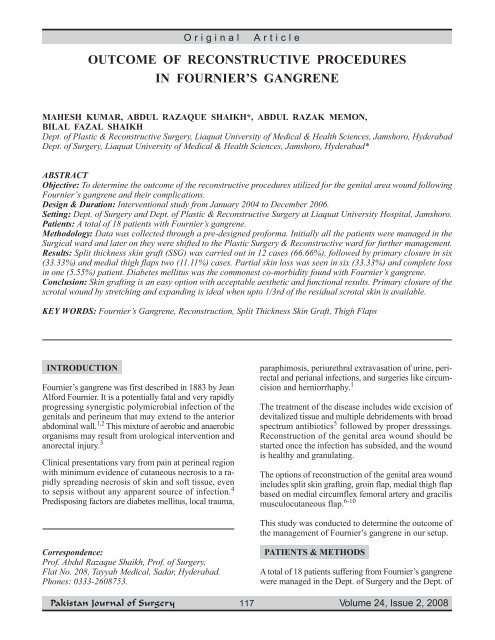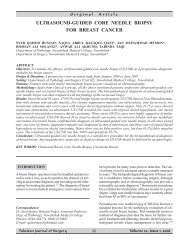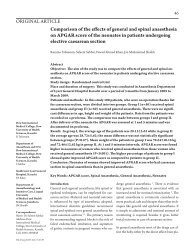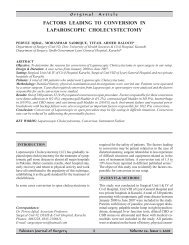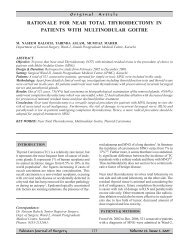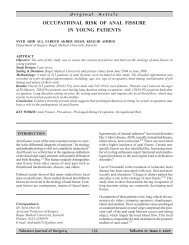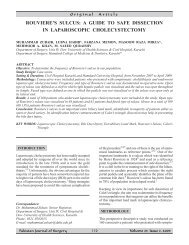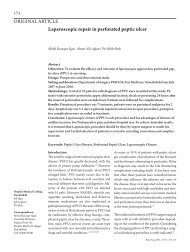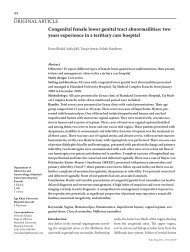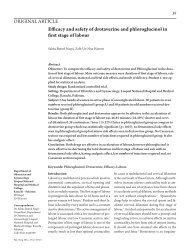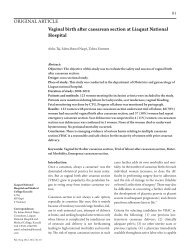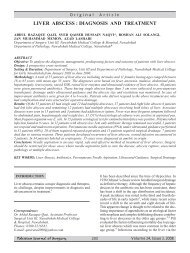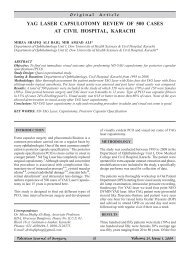Outcome of Reconstructive Procedures in Fournier's Gangrene
Outcome of Reconstructive Procedures in Fournier's Gangrene
Outcome of Reconstructive Procedures in Fournier's Gangrene
You also want an ePaper? Increase the reach of your titles
YUMPU automatically turns print PDFs into web optimized ePapers that Google loves.
Orig<strong>in</strong>al Article<br />
OUTCOME OF RECONSTRUCTIVE PROCEDURES<br />
IN FOURNIER’S GANGRENE<br />
MAHESH KUMAR, ABDUL RAZAQUE SHAIKH*, ABDUL RAZAK MEMON,<br />
BILAL FAZAL SHAIKH<br />
Dept. <strong>of</strong> Plastic & <strong>Reconstructive</strong> Surgery, Liaquat University <strong>of</strong> Medical & Health Sciences, Jamshoro, Hyderabad<br />
Dept. <strong>of</strong> Surgery, Liaquat University <strong>of</strong> Medical & Health Sciences, Jamshoro, Hyderabad*<br />
ABSTRACT<br />
Objective: To determ<strong>in</strong>e the outcome <strong>of</strong> the reconstructive procedures utilized for the genital area wound follow<strong>in</strong>g<br />
Fournier’s gangrene and their complications.<br />
Design & Duration: Interventional study from January 2004 to December 2006.<br />
Sett<strong>in</strong>g: Dept. <strong>of</strong> Surgery and Dept. <strong>of</strong> Plastic & <strong>Reconstructive</strong> Surgery at Liaquat University Hospital, Jamshoro.<br />
Patients: A total <strong>of</strong> 18 patients with Fournier’s gangrene.<br />
Methodology: Data was collected through a pre-designed pr<strong>of</strong>orma. Initially all the patients were managed <strong>in</strong> the<br />
Surgical ward and later on they were shifted to the Plastic Surgery & <strong>Reconstructive</strong> ward for further management.<br />
Results: Split thickness sk<strong>in</strong> graft (SSG) was carried out <strong>in</strong> 12 cases (66.66%), followed by primary closure <strong>in</strong> six<br />
(33.33%) and medial thigh flaps two (11.11%) cases. Partial sk<strong>in</strong> loss was seen <strong>in</strong> six (33.33%) and complete loss<br />
<strong>in</strong> one (5.55%) patient. Diabetes mellitus was the commonest co-morbidity found with Fournier’s gangrene.<br />
Conclusion: Sk<strong>in</strong> graft<strong>in</strong>g is an easy option with acceptable aesthetic and functional results. Primary closure <strong>of</strong> the<br />
scrotal wound by stretch<strong>in</strong>g and expand<strong>in</strong>g is ideal when upto 1/3rd <strong>of</strong> the residual scrotal sk<strong>in</strong> is available.<br />
KEY WORDS: Fournier’s <strong>Gangrene</strong>, Reconstruction, Split Thickness Sk<strong>in</strong> Graft, Thigh Flaps<br />
INTRODUCTION<br />
Fournier’s gangrene was first described <strong>in</strong> 1883 by Jean<br />
Alford Fournier. It is a potentially fatal and very rapidly<br />
progress<strong>in</strong>g synergistic polymicrobial <strong>in</strong>fection <strong>of</strong> the<br />
genitals and per<strong>in</strong>eum that may extend to the anterior<br />
abdom<strong>in</strong>al wall. 1,2 This mixture <strong>of</strong> aerobic and anaerobic<br />
organisms may result from urological <strong>in</strong>tervention and<br />
anorectal <strong>in</strong>jury. 3<br />
Cl<strong>in</strong>ical presentations vary from pa<strong>in</strong> at per<strong>in</strong>eal region<br />
with m<strong>in</strong>imum evidence <strong>of</strong> cutaneous necrosis to a rapidly<br />
spread<strong>in</strong>g necrosis <strong>of</strong> sk<strong>in</strong> and s<strong>of</strong>t tissue, even<br />
to sepsis without any apparent source <strong>of</strong> <strong>in</strong>fection. 4<br />
Predispos<strong>in</strong>g factors are diabetes mellitus, local trauma,<br />
Correspondence:<br />
Pr<strong>of</strong>. Abdul Razaque Shaikh, Pr<strong>of</strong>. <strong>of</strong> Surgery,<br />
Flat No. 208, Tayyab Medical, Sadar, Hyderabad.<br />
Phones: 0333-2608753.<br />
117<br />
paraphimosis, periurethral extravasation <strong>of</strong> ur<strong>in</strong>e, perirectal<br />
and perianal <strong>in</strong>fections, and surgeries like circumcision<br />
and herniorrhaphy. 1<br />
The treatment <strong>of</strong> the disease <strong>in</strong>cludes wide excision <strong>of</strong><br />
devitalized tissue and multiple debridements with broad<br />
spectrum antibiotics 5 followed by proper dresss<strong>in</strong>gs.<br />
Reconstruction <strong>of</strong> the genital area wound should be<br />
started once the <strong>in</strong>fection has subsided, and the wound<br />
is healthy and granulat<strong>in</strong>g.<br />
The options <strong>of</strong> reconstruction <strong>of</strong> the genital area wound<br />
<strong>in</strong>cludes split sk<strong>in</strong> graft<strong>in</strong>g, gro<strong>in</strong> flap, medial thigh flap<br />
based on medial circumflex femoral artery and gracilis<br />
musculocutaneous flap. 6-10<br />
This study was conducted to determ<strong>in</strong>e the outcome <strong>of</strong><br />
the management <strong>of</strong> Fournier’s gangrene <strong>in</strong> our setup.<br />
PATIENTS & METHODS<br />
A total <strong>of</strong> 18 patients suffer<strong>in</strong>g from Fournier’s gangrene<br />
were managed <strong>in</strong> the Dept. <strong>of</strong> Surgery and the Dept. <strong>of</strong><br />
Volume 24, Issue 2, 2008
<strong>Outcome</strong> <strong>of</strong> <strong>Reconstructive</strong> <strong>Procedures</strong> <strong>in</strong> Fournier’s <strong>Gangrene</strong> M. Kumar, A. R. Shaikh, et al<br />
Cause<br />
Urological<br />
Anorectal<br />
Unknown<br />
Table I. Aetiology <strong>of</strong> Fournier’s <strong>Gangrene</strong><br />
Plastic & <strong>Reconstructive</strong> Surgery at Liaquat University<br />
Hospital, Jamshoro from January 2004 to December<br />
2006.<br />
Detailed history and exam<strong>in</strong>ation <strong>of</strong> the cases was carried<br />
out and appropriate <strong>in</strong>vestigations done. After preparation<br />
surgical debridement was performed followed<br />
by dress<strong>in</strong>gs till <strong>in</strong>fection had subsided and the wound<br />
had healthy granulations. The wound was f<strong>in</strong>ally covered<br />
by either the approximation <strong>of</strong> sk<strong>in</strong>, split sk<strong>in</strong> grafts or<br />
flaps.<br />
RESULTS<br />
Eighteen patients with Fournier’s gangrene were managed<br />
dur<strong>in</strong>g the study period. All were male with ages<br />
rang<strong>in</strong>g between 30-60 years, mean age was 42 years.<br />
The causes were urological (urethral stricture with dilatation,<br />
traumatic catheterization) <strong>in</strong> 10 (55.55%) cases<br />
and anorectal (fissure-<strong>in</strong>-ano, hemorrhoidectomy) <strong>in</strong><br />
two (11.11%) cases (Table I). Associated diseases were<br />
diabetes mellitus <strong>in</strong> three (16.66%) and hypertension<br />
Site Involved<br />
Scrotum alone<br />
Scrotum + penis<br />
Number<br />
10<br />
Scrotum + penis + per<strong>in</strong>eum<br />
Scrotum + per<strong>in</strong>eum<br />
Scrotum + penis + pubic region<br />
2<br />
6<br />
%<br />
55.55<br />
11.11<br />
33.33<br />
No. <strong>of</strong> Patients<br />
7<br />
5<br />
3<br />
2<br />
1<br />
118<br />
Complication<br />
Partial sk<strong>in</strong> loss<br />
Complete sk<strong>in</strong> loss<br />
Hematoma<br />
Partial dehiscene<br />
<strong>in</strong> two (11.11%) patients.<br />
As far as the site was concerned, scrotum was <strong>in</strong>volved<br />
<strong>in</strong> all cases (100%), followed by penis <strong>in</strong> n<strong>in</strong>e (50%)<br />
cases (Table II). Split thickness sk<strong>in</strong> graft (SSG) was<br />
the commonest procedure done <strong>in</strong> 12 (66.66%) cases<br />
followed by primary closure <strong>in</strong> six (33.33%) and medial<br />
thigh flaps <strong>in</strong> two (11.11%) cases. Two patients out <strong>of</strong><br />
18 had exposed testis which were burried <strong>in</strong> thigh followed<br />
by medial thigh flaps and scrotoplasty six months<br />
later (Figs. 1-3).<br />
Partial sk<strong>in</strong> loss was seen <strong>in</strong> six (33.33%) and complete<br />
loss <strong>in</strong> on (5.55%) patient; they were re-grafted after<br />
one week. No flap loss or mortality was seen <strong>in</strong> this<br />
study (Table III).<br />
DISCUSSION<br />
All patients with Fournier’s gangrene treated at Liaquat<br />
University Hospital were males. The absence <strong>of</strong> females<br />
Primary closure 3 cases (42.85%)<br />
S.S.G 3 cases (42.85%)<br />
Medial Thigh flap 1 cases (14.28%)<br />
Primary closure 1 cases (20%)<br />
S.S.G 3 cases (60%)<br />
Medial Thigh flap 1 cases (20%)<br />
S.S.G + Primary closure <strong>of</strong> per<strong>in</strong>eum<br />
3 cases (100%)<br />
S.S.G + Primary closure with local flaps<br />
2 cases (100%)<br />
S.S.G + Primary closure with local flaps<br />
2 cases (100%)<br />
Table III. Postoperative Complications<br />
Table II. Regions <strong>in</strong>volved and the procedures performed<br />
Procedure Performed<br />
No.<br />
6<br />
1<br />
1<br />
1<br />
%<br />
%<br />
33.33<br />
5.55<br />
5.55<br />
5.55<br />
38.88<br />
27.77<br />
16.66<br />
11.11<br />
5.55<br />
Volume 24, Issue 2, 2008
<strong>Outcome</strong> <strong>of</strong> <strong>Reconstructive</strong> <strong>Procedures</strong> <strong>in</strong> Fournier’s <strong>Gangrene</strong> M. Kumar, A. R. Shaikh, et al<br />
Fig. 1. (A) Preoperative (B) 1 week postoperative S.S.G (C) 2 weeks postoperative S.S.G<br />
Fig. 2. (A) Preoperative (B) Postop. Primary closure (C) Postop. Pr. closure 2 weeks<br />
Fig. 3. (A) Preoperative (B) Postop. Medial thigh flap (C) Postoperative 2 weeks<br />
119 Volume 24, Issue 2, 2008
<strong>Outcome</strong> <strong>of</strong> <strong>Reconstructive</strong> <strong>Procedures</strong> <strong>in</strong> Fournier’s <strong>Gangrene</strong> M. Kumar, A. R. Shaikh, et al<br />
<strong>in</strong> this study may be due to social or religious grounds.<br />
However, the low <strong>in</strong>cidence <strong>of</strong> females can also be attributed<br />
to better dra<strong>in</strong>age <strong>of</strong> the perianal region through<br />
vag<strong>in</strong>al secretions. 16<br />
All 18 patients with Fournier’s gangrene were <strong>in</strong>itially<br />
treated <strong>in</strong> the surgical ward with dress<strong>in</strong>gs, debridements<br />
and antibiotics. Once the wounds granulate and become<br />
<strong>in</strong>fection free, they were sent to the plastic surgery ward<br />
for further management. In our study no patient died<br />
due to Fournier’s gangrene though the literature mentions<br />
a mortality rate vary<strong>in</strong>g between 3-67%. 12,13<br />
In this study the cause may be decreased host resistance<br />
and ascend<strong>in</strong>g <strong>in</strong>fection from perirectal site and urethra.<br />
Diabetes is the lead<strong>in</strong>g cause <strong>of</strong> Fournier’s gangrene<br />
due to <strong>in</strong>creased propensity <strong>of</strong> tissue ischemia caused<br />
by small blood vessel disease. 14 In our study also diabetes<br />
was the ma<strong>in</strong> co-morbid condition. Pizzomo et al<br />
described an <strong>in</strong>creased <strong>in</strong>cidence (upto 50%) <strong>of</strong> Fournier’s<br />
gangrene with diabetes mellitus. 15<br />
None <strong>of</strong> the patients <strong>in</strong> our study required orchidectomy,<br />
penectomy or colostomy. Split thickness sk<strong>in</strong> graft<strong>in</strong>g<br />
was the ideal procedure <strong>in</strong> this series, which was done<br />
<strong>in</strong> 11 (61.11%) cases. Stretch and expansion <strong>of</strong> residual<br />
scrotal sk<strong>in</strong> with primary closure was done <strong>in</strong> 4 (22.22%)<br />
patients; when up to 1/3rd <strong>of</strong> scrotum is <strong>in</strong>tact it can be<br />
expanded to resurface the entire scrotum. 18<br />
In this study we used the superiomedial thigh fasciocutaneous<br />
flap <strong>in</strong> 2 (11.11%) patients. The testes were<br />
burried <strong>in</strong> a pouch <strong>in</strong> the superio-medial aspect <strong>of</strong> the<br />
thigh <strong>in</strong> those patients who had complete scrotal loss<br />
follow<strong>in</strong>g Fournier’s gangrene. This flap is based on<br />
the medial circumflex artery perforators, deep external<br />
pudendal artery and anterior branch <strong>of</strong> obturator artery. 9<br />
It is a safe and s<strong>in</strong>gle stage procedure with good aesthetic<br />
results and provides sensory coverage because <strong>of</strong> genital<br />
branch <strong>of</strong> genit<strong>of</strong>emoral nerve and ilio<strong>in</strong>gu<strong>in</strong>al nerve. 16<br />
The musculocutaneous flap was not utilized <strong>in</strong> our<br />
study.<br />
Six (33.33%) cases out <strong>of</strong> 18 had partial and 5.55%<br />
complete sk<strong>in</strong> loss. The latter was seen <strong>in</strong> one diabetic<br />
patient who was re-grafted after one week. Sk<strong>in</strong> graft<strong>in</strong>g<br />
was found to be a technically easy option with satisfactory<br />
cosmetic and functional results. 6 Hyperbaric oxygen<br />
therapy was not done <strong>in</strong> this study though it has a vital<br />
role <strong>in</strong> the management. 15,17<br />
CONCLUSION<br />
Split thickness sk<strong>in</strong> graft<strong>in</strong>g is an ideal procedure for<br />
genital area resurfac<strong>in</strong>g; primary closure <strong>of</strong> scrotum by<br />
120<br />
stretch<strong>in</strong>g and expand<strong>in</strong>g should be used when up to<br />
1/3rd <strong>of</strong> the residual scrotum is available. Superiomedial<br />
thigh flap is reliable with less complication as comparative<br />
to other flaps. Partial thickness sk<strong>in</strong> loss is the<br />
common complication <strong>of</strong> sk<strong>in</strong> graft<strong>in</strong>g.<br />
REFERENCES<br />
1. Klic A, Aksoy Y, Klic A. Fournier’s gangrene: Etiology,<br />
treatment and complication. Ann Plastic Surg<br />
2001; 47: 523.<br />
2. Xeropotamos NS, Nousias VE, Kappas AM. Fournier’s<br />
gangrene: Diagnostic approach and therapeutic<br />
challenge. Eur J Surg 2002; 168: 91-95.<br />
3. Shaikh AR. Fournier’s gangrene - urological emergency.<br />
J Surg Pak 1999; 4(1):22-4.<br />
4. Morpurgo E, Galanduck S. Fournier’s gangrene.<br />
Surg Cl N America 2002; 82: 1213-24.<br />
5. Spirnak JP, Resnick MI, Hampel N, Persky L. Fournier’s<br />
gangrene: Report <strong>of</strong> 20 patients. J Uro 1984;<br />
131: 289-91.<br />
6. Magu<strong>in</strong>a P, Palmieri TL, Green-Halgh DG. Split<br />
thickness sk<strong>in</strong> graft<strong>in</strong>g for re-creation <strong>of</strong> scrotum<br />
follow<strong>in</strong>g Fournier gangrene. Burns 2004 Aug;<br />
30(5): 505.<br />
7. Cannistrac, Kirsch-Noir F, Delmasv, Marmus JP,<br />
Boccon-Gibod L. Scrotal reconstruction by <strong>in</strong>gu<strong>in</strong>al<br />
flap after Fournier’s gangrene. Prog Urol 2003 Sep;<br />
13(4): 703-6.<br />
8. Atik B, Tan O, Ceylan K, Etlik O, Demir C. Reconstruction<br />
<strong>of</strong> wide scrotal defect us<strong>in</strong>g suprath<strong>in</strong> gro<strong>in</strong><br />
flap. Urology 2006 Aug; 68(2): 419-22.<br />
9. Hallock GG. Scrotal reconstruction follow<strong>in</strong>g Fournier’s<br />
gangrene us<strong>in</strong>g the medial circumflex artery<br />
flap. Ann Plast Surg 2006 Sep; 57(3): 333.<br />
10. Sretenoric N, Colic M, Lazic R, Bosic S, Stojad<strong>in</strong>ovic<br />
N. Fournier’s gangrene and reconstruction <strong>of</strong><br />
it defects. Acta chirlugosl 2006; 53(3): 95-9.<br />
11. Korkut M, Icoz G, Dayangac M, et al. <strong>Outcome</strong><br />
analysis <strong>in</strong> patients with Fournier’s gangrene, report<br />
<strong>of</strong> 45 cases. Dis Colon Rectum 2003 May; 46(5):<br />
649-52.<br />
12. Hejase M, Simor<strong>in</strong> JE, Bihrle R, Coogar CL. Genital<br />
Fournier’s gangrene: experience with 38 patients.<br />
Volume 24, Issue 2, 2008
<strong>Outcome</strong> <strong>of</strong> <strong>Reconstructive</strong> <strong>Procedures</strong> <strong>in</strong> Fournier’s <strong>Gangrene</strong> M. Kumar, A. R. Shaikh, et al<br />
Urology 1996; 47: 734.<br />
13. Corman JM, Moody JA, Arson WJ. Fournier’s<br />
gangrene <strong>in</strong> modern surgical sett<strong>in</strong>g: Improved survival<br />
with aggressive management. Br J Urol Intl<br />
1999; 84: 85.<br />
14. Bask<strong>in</strong> IS, Carroll PR, Caltolica EV, et al. Necrotiz<strong>in</strong>g<br />
s<strong>of</strong>t tissue <strong>in</strong>fections <strong>of</strong> per<strong>in</strong>eum and genitalia.<br />
Br J Urol 1990; 65: 524-9.<br />
15. Pizzorno R, Bon<strong>in</strong>i F, Donelli A, Stub<strong>in</strong>ski R, Medica<br />
M, Carmignani G. Hyperbaric oxygen therapy<br />
<strong>in</strong> the treatment <strong>of</strong> Fournier’s disease <strong>in</strong> male pati-<br />
ents. J Urol 1997; 158: 837-40.<br />
16. Ferrira PC, Reis JC, Amarnte JM, Silva AC. Fournier’s<br />
gangrene: A review <strong>of</strong> 43 cases. Plast Reconst<br />
Surg 2007; 119: 175-84.<br />
17. Capelli-Schellpteffer M, Gereber GS. The use <strong>of</strong><br />
Hyperbaric oxygen <strong>in</strong> urology. J Urology 1999;<br />
162: 647.<br />
18. Por YC, Tan BK, Hong SW, et al. Use <strong>of</strong> scrotal<br />
remanent as a tissue expand<strong>in</strong>g musculocutaneous<br />
flap for scrotal reconstruction <strong>in</strong> Paget’s disease.<br />
Ann Plastic Surg 2003; 51: 155.<br />
121 Volume 24, Issue 2, 2008


